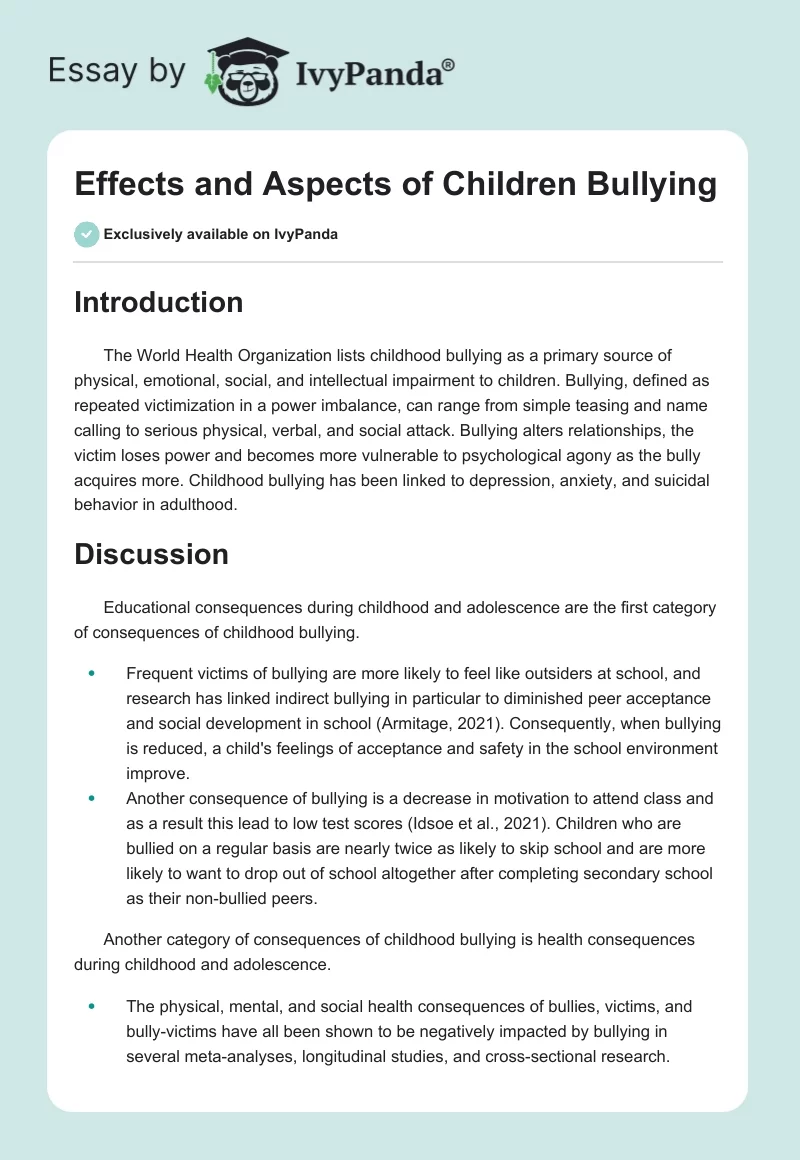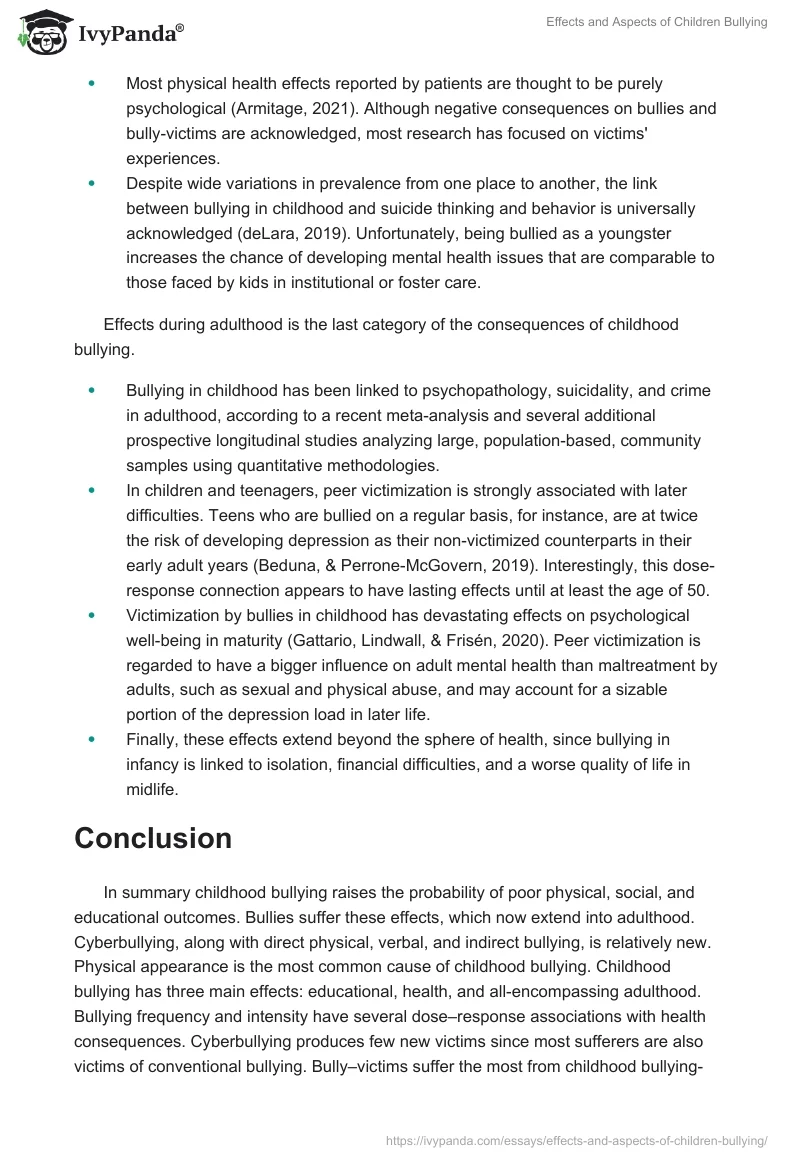Introduction
The World Health Organization lists childhood bullying as a primary source of physical, emotional, social, and intellectual impairment to children. Bullying, defined as repeated victimization in a power imbalance, can range from simple teasing and name calling to serious physical, verbal, and social attack. Bullying alters relationships, the victim loses power and becomes more vulnerable to psychological agony as the bully acquires more. Childhood bullying has been linked to depression, anxiety, and suicidal behavior in adulthood.
Discussion
Educational consequences during childhood and adolescence are the first category of consequences of childhood bullying.
- Frequent victims of bullying are more likely to feel like outsiders at school, and research has linked indirect bullying in particular to diminished peer acceptance and social development in school (Armitage, 2021). Consequently, when bullying is reduced, a child’s feelings of acceptance and safety in the school environment improve.
- Another consequence of bullying is a decrease in motivation to attend class and as a result this lead to low test scores (Idsoe et al., 2021). Children who are bullied on a regular basis are nearly twice as likely to skip school and are more likely to want to drop out of school altogether after completing secondary school as their non-bullied peers.
Another category of consequences of childhood bullying is health consequences during childhood and adolescence.
- The physical, mental, and social health consequences of bullies, victims, and bully-victims have all been shown to be negatively impacted by bullying in several meta-analyses, longitudinal studies, and cross-sectional research.
- Most physical health effects reported by patients are thought to be purely psychological (Armitage, 2021). Although negative consequences on bullies and bully-victims are acknowledged, most research has focused on victims’ experiences.
- Despite wide variations in prevalence from one place to another, the link between bullying in childhood and suicide thinking and behavior is universally acknowledged (deLara, 2019). Unfortunately, being bullied as a youngster increases the chance of developing mental health issues that are comparable to those faced by kids in institutional or foster care.
Effects during adulthood is the last category of the consequences of childhood bullying.
- Bullying in childhood has been linked to psychopathology, suicidality, and crime in adulthood, according to a recent meta-analysis and several additional prospective longitudinal studies analyzing large, population-based, community samples using quantitative methodologies.
- In children and teenagers, peer victimization is strongly associated with later difficulties. Teens who are bullied on a regular basis, for instance, are at twice the risk of developing depression as their non-victimized counterparts in their early adult years (Beduna, & Perrone-McGovern, 2019). Interestingly, this dose-response connection appears to have lasting effects until at least the age of 50.
- Victimization by bullies in childhood has devastating effects on psychological well-being in maturity (Gattario, Lindwall, & Frisén, 2020). Peer victimization is regarded to have a bigger influence on adult mental health than maltreatment by adults, such as sexual and physical abuse, and may account for a sizable portion of the depression load in later life.
- Finally, these effects extend beyond the sphere of health, since bullying in infancy is linked to isolation, financial difficulties, and a worse quality of life in midlife.
Conclusion
In summary childhood bullying raises the probability of poor physical, social, and educational outcomes. Bullies suffer these effects, which now extend into adulthood. Cyberbullying, along with direct physical, verbal, and indirect bullying, is relatively new. Physical appearance is the most common cause of childhood bullying. Childhood bullying has three main effects: educational, health, and all-encompassing adulthood. Bullying frequency and intensity have several dose–response associations with health consequences. Cyberbullying produces few new victims since most sufferers are also victims of conventional bullying. Bully–victims suffer the most from childhood bullying-related mental health issues. Whole-school cooperative learning interventions are the most effective in preventing bullying, which is crucial to achieving the Sustainable Development Goals. Despite local and online expert resources, primary and secondary care lacks clear management and referral mechanisms for health professionals dealing with children bullying.
References
Armitage, R. (2021). Bullying in children: impact on child health. BMJ paediatrics open, 5(1), 1-104. Web.
Beduna, K. N., & Perrone-McGovern, K. M. (2019). Recalled childhood bullying victimization and shame in adulthood: The influence of attachment security, self-compassion, and emotion regulation. Traumatology, 25(1), 21. Web.
deLara, E. W. (2019). Consequences of childhood bullying on mental health and relationships for young adults. Journal of Child and Family Studies, 28(9), 2379-2389. Web.
Gattario, K. H., Lindwall, M., & Frisén, A. (2020). Life after childhood bullying: Body image development and disordered eating in adulthood. International Journal of Behavioral Development, 44(3), 246-255. Web.
Idsoe, T., Vaillancourt, T., Dyregrov, A., Hagen, K. A., Ogden, T., & Nærde, A. (2021). Bullying victimization and trauma. Frontiers in psychiatry, 11(5), 480353. Web.


